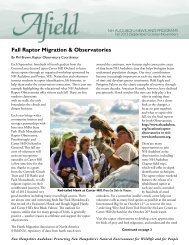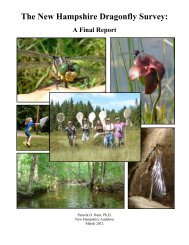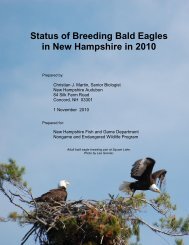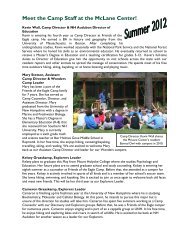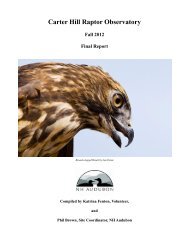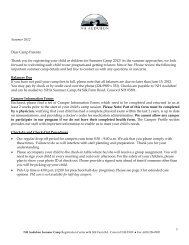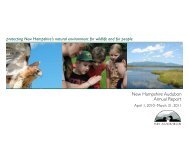2012 Annual Report - New Hampshire Audubon
2012 Annual Report - New Hampshire Audubon
2012 Annual Report - New Hampshire Audubon
- No tags were found...
You also want an ePaper? Increase the reach of your titles
YUMPU automatically turns print PDFs into web optimized ePapers that Google loves.
Golden Eagle (Aquila chrysaetos)<strong>2012</strong> Season Total: 5 [November: 22005-11 Average: 7.0 (includes Nov. records) [Season Record High: 11 (2006)Single-day High: 2 (Oct. 25) [Single-day Record High: 3 (10/30/06, 11/3/06)The rarest of the annual visitors to the hawk-watch,and far and away the raptor most eagerly awaited bythe hardy October faithful, the Golden Eagle seems toinspire that mixture of awe and excitement usuallyreserved for pop stars or ancient ancestors risen fromthe grave. Part of the bird’s mythic aura comes fromits—possibly imagined—tendency to arrive duringperiods of extremity: if you are standing on theplatform experiencing extreme boredom, extremecold, or feel yourself under physical or emotionalduress, the next bird to appear will almost certainly be that jewel in the crown of any <strong>New</strong> England birder,a ridge-riding Golden Eagle. Its size, but also the peculiar ripple that runs through its long, hawk-likewing, the ease with which it makes progress even into a headwind, the sheen off its dark dark feathers…What exactly makes a golden beautiful is a matter of some debate, but nowhere is its beauty in question.One primary goal of the extended November count period was to help give a more complete picture ofGolden Eagle migration through the area. The species is a late-season migrant, with many birds thought topass in those weeks after the official count period has come to an end. From this perspective, Novemberwas a bit of a disappointment, with only 2 goldens spotted, and those in the first five days of the month.With warm weather and strong southerly flow persisting even into the middle of November, one mayspeculate that their migration was slightly delayed, but data from other watch sites does not support this.Pack’s average count of 7 birds a year is a very small sample;even the broadest conclusions about the species are difficult tosupport with our own available statistical evidence. Of theyear’s 7 goldens, 4 were first-year juveniles, 1 was immature,and 2 were full adults.Immature Golden EaglePhoto by John Terescik<strong>New</strong> research using satellite transmitters is beginning to yieldexciting new information about the eastern Golden Eaglepopulation. Migration seems to follow two main patterns: thebirds seen at Pack are likely originating in the Gaspépeninsula of Quebec, south of the St. Lawrence, while birdsfrom Labrador and Greenland—a far larger number—travelwest of us, through <strong>New</strong> York and Pennsylvania. (HawkMountain saw 172 goldens this fall, including 48 in a singleday!)10



